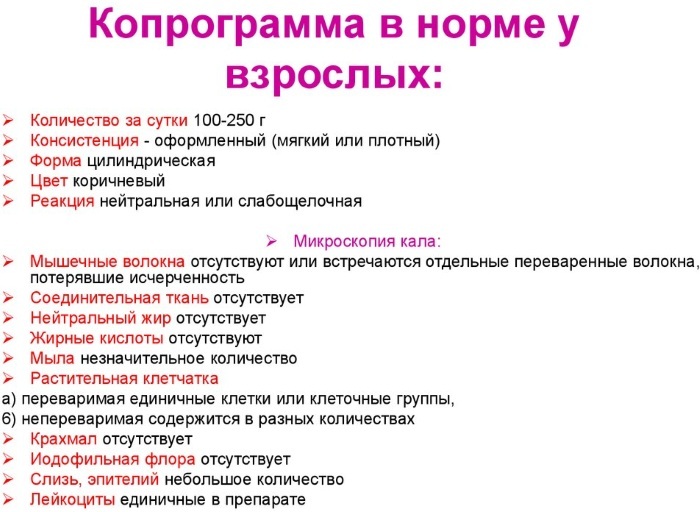Gastritis - inflammatory or an inflammatory-dystrophic change in the gastric mucosa, leading to a decrease in the quality of food processing with gastric juice, disruption of the normal functioning of the gastrointestinal tract.
In women, the disease is often confused with symptoms of gynecological diseases or PMS. If not timely recognized and taken medical measures, gastritis gives rise to serious health problems.
Record content:
- 1 What is gastritis
- 2 Classification
-
3 Forms of acute gastritis
- 3.1 Catarrhal form of acute gastritis
- 3.2 Fibrinous form of acute gastritis
- 3.3 Necrotic gastritis
- 3.4 Phlegmonous form of gastritis
-
4 Forms of chronic gastritis
- 4.1 Autoimmune (atrophic) gastritis
- 4.2 Bacterial gastritis
- 4.3 Chemical gastritis
- 5 Other forms of gastritis
- 6 Causes of occurrence in women
-
7 Symptoms
- 7.1 Common symptoms of gastritis
- 7.2 Symptoms of acute gastritis
- 7.3 Chronic gastritis symptoms
- 8 Gastritis in postmenopausal women
-
9 Treatment
- 9.1 Drug treatment
- 9.2 Folk remedies, homeopathy
- 9.3 Diet, permitted and prohibited foods
- 10 Clinical guidelines
- 11 Video about gastritis
What is gastritis
In most cases (about 90%), the factor provoking the disease is the microorganism Helicobacter Pilori. Under its influence, the pathological process affects the parts of the stomach, as a result of which they become thinner and deformed.
In one form or another, gastritis affects about only 70% of the world's population. The first signs begin to appear in people aged 12-18 years in 82% of patients.
Gastritis, left unattended or not completely cured, causes serious complications in the work of the organs of the gastrointestinal tract. He can turn into peptic ulcer of the duodenum and stomach, purulent peritonitis, sepsis. In 1-2% of people, gastritis will provoke stomach cancer.
Classification
Gastritis, the symptoms and treatment of which in adult women and men differ in many ways, depending on their species, classified in 1990 at the IX International Congress of Gastroenterologists, which was held in Australia.
It adopted a worldwide classification of the disease according to 4 parameters:
- By the type of gastritis, there are:
- acute gastritis;
- chronic gastritis.

- By the location of the inflammatory process in the stomach (topography):
- antrum gastritis (the focus of inflammation is located closer to the intestines);
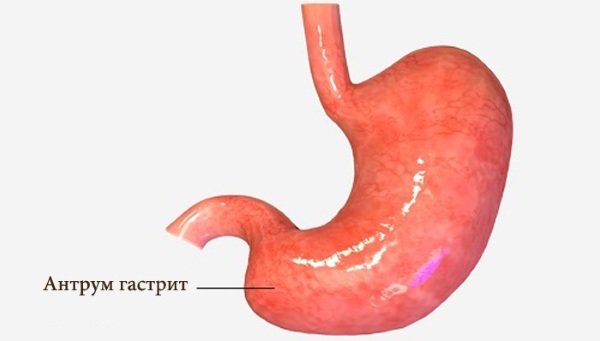
- gastritis of the body of the stomach;
- pangastritis (whole stomach).
- By the form and structure of inflammation (by morphology). In this category, gastritis is distinguished:
- by the degree of inflammation, that is, how much the mucous membrane has changed;
- by the degree of activity, that is, how much the body tries to defend itself at the cellular level;
- by the severity of atrophy, that is, how much the gastric glands are depressed;
- by the presence of metaplasia (replacement of cells of the gastric mucosa with cells of the small or large intestine);
- by the degree of colonization of Helicobacter Pilori bacteria.
By the production of gastric juice, the following are distinguished:
- Hyperacid gastritis (with high acidity).
- Hypoacid gastritis (low acidity).
Forms of acute gastritis
Gastritis in women, the symptoms of which appear abruptly and suddenly, is called acute. Usually it manifests itself at the initial occurrence, but it can also appear later, especially in people over 65 years of age.
Depending on the degree of damage to the gastric mucosa, the following forms of acute gastritis are distinguished:
- catarrhal.
- fibrinous.
- necrotic
- phlegmonous.
Depending on the degree of mucosal damage, acute gastritis is divided into: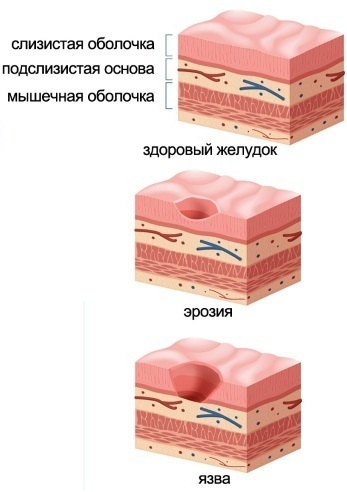
- First degree of severity. The mucous membrane has been partially or superficially affected. The symptoms are moderate.
- Second degree of severity. The lesions are deeper, the symptoms are more pronounced.
- Third degree of severity. Severe damage, the digestive function is completely impaired. Symptoms are pronounced, accompanied by a high body temperature. Treatment of this gastritis is carried out only in stationary conditions.
Depending on the localization of the lesion, acute gastritis is divided into:
- Focal (local):
- fundic (inflammation of the fundus of the stomach);
- antral;
- piloantral;
- piloduodenal.
- Diffuse (widespread) or pangastritis.
Catarrhal form of acute gastritis
This is the most common form of gastritis. It is characterized only by superficial lesions of the gastric mucosa. More often it occurs as a reaction to food, medicines.
Also, stress, pregnancy, hormonal imbalance can be provoking factors. With this form of gastritis, a large amount of mucus is observed inside the stomach. The site of inflammation is edematous and full-blooded, the presence of small-point hemorrhages is possible.
The symptoms of catarrhal gastritis appear in the first hours after eating or taking medication.
This is:
- pain in the epigastric region of mild or moderate severity;
- loose stools;
- temperature rise to 37-38 С °
- lethargy, weakness.

Untreated catarrhal acute gastritis develops into a chronic one, as well as into more dangerous forms, for example, into acute phlegmonous.
Fibrinous form of acute gastritis
A feature of fibrinous gastritis is the formation of fibrinous or fibrinous-purulent exudate. Exudate is a cloudy fluid that is released from small blood vessels due to inflammatory changes in the tissues of the stomach. In its composition, it contains more than 2% of proteins - fibrins.
This protein has a fibrous structure. As a result, the site of inflammation is covered with a yellow-brown or gray film-like coating, and underneath there are necrotic changes in the mucous membrane (tissue necrosis, erosion).
Fibrinous gastritis occurs in severe infectious diseases, poisoning with mercuric chloride and some acids. This is a rare form of gastritis.
Necrotic gastritis
With necrotizing gastritis, the lesion extends deep into the mucous membrane of the stomach. It can reach the muscle layer with the formation of deep erosions and ulcers, up to a hole in the wall of the stomach.
The main cause of necrotizing gastritis is poisoning with toxic drugs and substances, alcohol. Necrotizing gastritis often occurs with ulcers, disintegrating tumors, severe stomach injuries. Symptoms appear in the first hours after poisoning.
The main symptoms are:
- severe burning pains in the mouth, throat, throughout the gastrointestinal tract;
- vomiting mixed with blood and particles of the gastric mucosa;
- intense thirst;
- strong foamy salivation;
- dizziness, weakness.
First aid for necrotizing gastritis is gastric lavage. Subsequent treatment is carried out only in an inpatient setting.
Phlegmonous form of gastritis
Sometimes not completely cured catarrhal gastritis can develop into its phlegmonous form. It is characterized by purulent inflammation that can affect all layers of the stomach (mucous membrane, submucosa, muscle layer).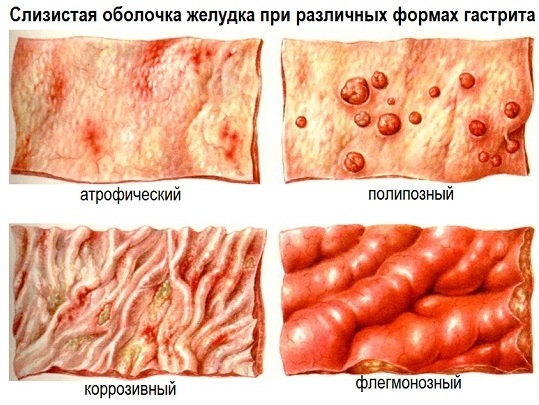
The walls of the stomach with phlegmonous gastritis thicken. The risk of developing perigastritis and peritonitis increases. With perigastritis, inflammation from the stomach wall passes to the adjacent organs. With peritonitis, inflammation of the peritoneum occurs.
Basically, the factors in the occurrence of phlegmonous gastritis are bacteria and various infections localized in the stomach. In 75% of cases, the causative agent is streptococcus. But often it is caused by staphylococci, pneumococci, Escherichia coli.
This is a rare type of gastritis. But at the same time, it is characterized by a rather severe course and a high risk of death.
The main symptoms of phlegmonous gastritis are:
- fever;
- cutting pains in the stomach and left hypochondrium, which can radiate to the abdominal or scapular region;
- vomiting with bile and blood;
- a sharp rise in temperature;
- general weakness, palpitations.
Treatment of phlegmonous gastritis is carried out only in a hospital.
Forms of chronic gastritis
Chronic gastritis, in accordance with the cause of its occurrence, is divided into 3 types: type A (autoimmune, atrophic), type B (bacterial), type C (chemical, reflux gastritis).
Autoimmune (atrophic) gastritis
Atrophic gastritis is a rather rare type of disease, usually diagnosed in 3-6% of patients. Autoimmune gastritis occurs when the immune system rejects cells in the stomach lining.
They are perceived as a foreign body that the body is trying to get rid of. As a result, immunoglobulin proteins are produced. Under their influence, there is a gradual disruption of the gastric mucosa.
Bacterial gastritis
This type of gastritis is caused by pathogenic or opportunistic microorganisms, mainly Helicobacter Pilori. 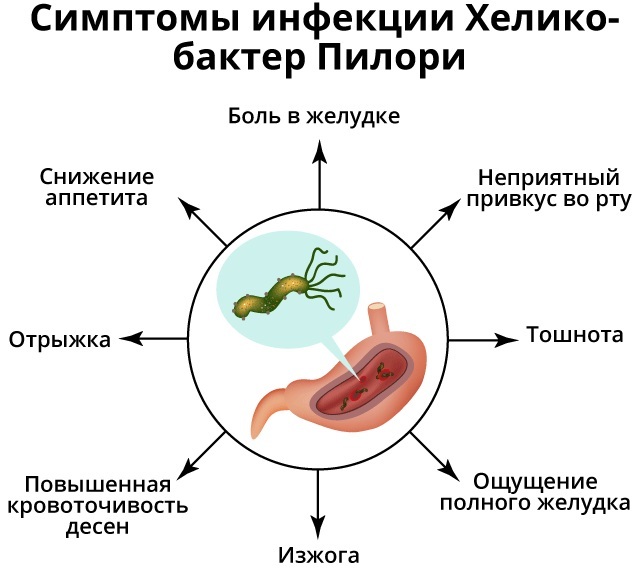 But it can also be provoked by staphylococcus, pneumococcus, Escherichia coli, streptococcus and other microorganisms. Bacterial gastritis is observed in 80-90% of patients.
But it can also be provoked by staphylococcus, pneumococcus, Escherichia coli, streptococcus and other microorganisms. Bacterial gastritis is observed in 80-90% of patients.
Chemical gastritis
In another way, this type of gastritis is called reflux gastritis. It is caused by the release of bile into the stomach. It dissolves the stomach lining and causes burns. This type of gastritis is typical for patients with pancreatitis, cholecystitis. It occurs in 7-15% of cases.
Other forms of gastritis
There are other forms of gastritis.
- Rigid (antral). It is characterized by lesions of the mucous membrane in the antrum of the stomach. This is the thick-walled region of the stomach, closer to the small intestine, where food is ground and mixed.
-
Giant hypertrophic. Differs in massive folds and polyposis adenomas.
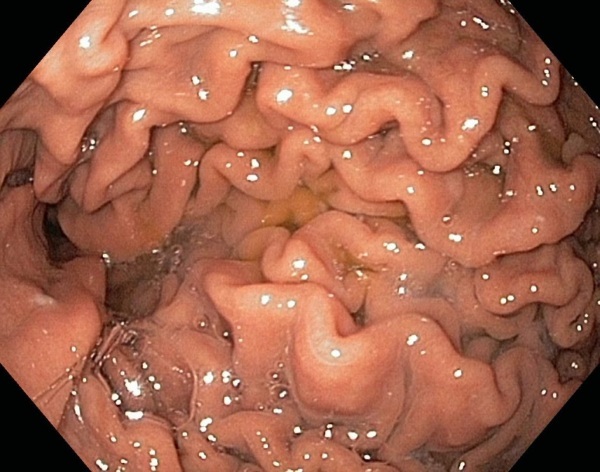
- Polypous. It is characterized by atrophy of the gastric mucosa, achlorhydria (that is, the absence of hydrochloric acid in the stomach).
Causes of occurrence in women
Gastritis in women, the symptoms of which are different, can occur for a variety of reasons.
There are 2 groups of factors:
- microbial;
- non-microbial.
The first group includes various pathogenic or opportunistic microorganisms. Moreover, in 90% of this factor is Helicobacter Pilori.
In addition to it, gastritis can be caused by:
- staphylococcus;
- streptococcus;
- colibacillus and others.
In addition, various viruses can be the cause of gastritis. It can occur against the background of tuberculosis, candidiasis, syphilis, helminthic invasions.
The non-microbial group of factors for the onset of gastritis include:
- Imbalance in nutrition and non-compliance with its regime. That is, the effect on the gastric mucosa of thermally, mechanically or chemically irritating products. This is the use of spicy, spoiled, hot food.
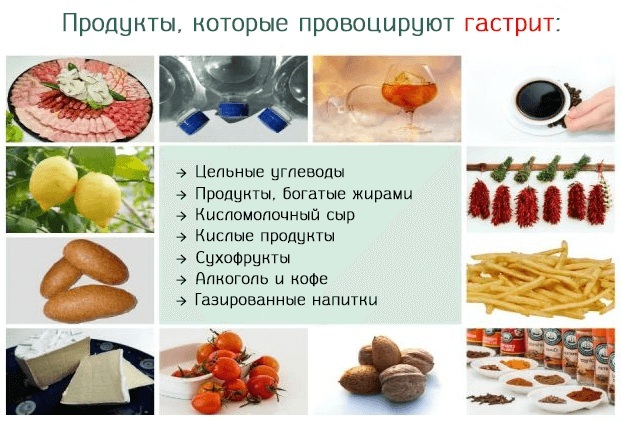
- An allergic reaction of the stomach lining to certain allergens.
- Autoimmune mechanism.
- Taking medications. Medicines that can trigger gastritis include non-steroidal anti-inflammatory drugs. drugs (Ibuprofen, Nurofen, Aspirin, Acetylsalicylic acid, Ketonal, Ibuclin, etc.), glucocorticoids, antibiotics.
- Duodenogastric reflux, that is, the throwing of the contents of the duodenum into the stomach cavity.
- Stress and nervous strain.
- Bad habits (alcohol and smoking).
- Metabolic disorders (obesity, gout, some diseases of the endocrine system).
- Chemical poisoning and occupational hazards.
- Radiation.
- Disruption of the transit of food through the gastrointestinal tract due to resection or other reasons.
Symptoms
Common symptoms of gastritis
Gastritis in women, the symptoms of which may not appear, is very dangerous. The main cues to watch out for are epigastric pain and heaviness in the abdomen, especially after eating or taking medications.
In addition, the common symptoms of gastritis are:
- Intermittent but prolonged heartburn.
- General weakness, dizziness.
- Stool problems (constipation, diarrhea).
- Increased gas formation.
- Lack of appetite and weight loss.
- Constant sleepiness and irritability.
- Disruption of the taste buds.
- Unpleasant belching, sometimes vomiting.
- Pain with an empty stomach.
- Fast food saturation.

- Intolerance to certain types of food.
Symptoms of acute gastritis
An exacerbation of gastritis is characterized by pronounced symptoms.
These include:
- Constant or variable pain in the epigastric region.
- Nausea, vomiting. In severe forms of gastritis, vomiting with an admixture of blood is possible.
- Constant thirst.
- High body temperature.
- Severe headaches.
- Belching, heartburn, burning in the chest.
Gastritis in women is a serious illness. If the above symptoms manifest, you should immediately contact a medical organization for qualified help.
Chronic gastritis symptoms
During chronic gastritis in women, both general and local symptoms may be present:
- Irregular bowel movements.
- Constipation or diarrhea.
- Increased gas formation.
- Weight loss.
- Mild pain in the diaphragm on an empty stomach or after eating spicy, fatty, or hot foods.
- Profuse perspiration after eating.
- Rapid fatigue, general weakness of the body.
- Grayish coating on the tongue.
- Sour breath.
Gastritis in postmenopausal women
Menopause is a hormonal reorganization of the whole organism, which affects all organs, including the digestive system. During postmenopause, the level of progesterone decreases, the metabolism slows down, and the work of the nervous system changes.
As a result of hormonal changes in the digestive tract, there is often a violation of the function of breaking down food. Consequently, the risk of obesity increases. In this regard, there is a high risk of gastritis or exacerbation of an existing one.
To prevent gastritis, postmenopausal women are advised to undergo a comprehensive medical examination. In particular, screening for blood levels of cholesterol, sugar, hemoglobin. If a woman has previously been diagnosed with gastritis, then it is imperative to undergo an ultrasound of the abdominal cavity and a study for Helicobacter Pilori.
Treatment
The main treatment for gastritis is aimed at eliminating the cause of its occurrence. Diagnostics is carried out to select the correct therapy.
It includes several stages:
- Collecting anamnesis.
- Examination of the patient.
- Laboratory research:
- general blood analysis;
- general urine analysis;
- FGDS (a probe with a camera is inserted through the patient's mouth into the stomach cavity, with the help of which the state of the gastric mucosa is examined);
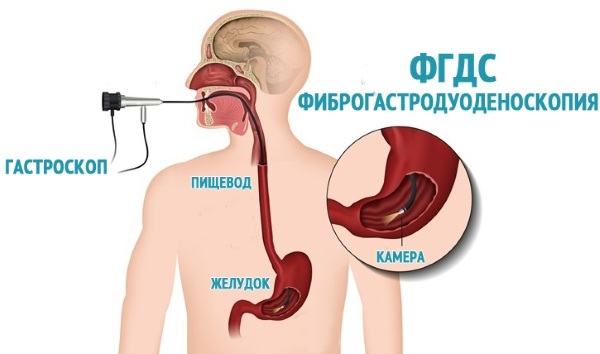
- biopsy;
- Ultrasound of the abdominal organs;
- radiography;
- breath test for the presence of Helicobacter Pilori.
When the diagnosis is confirmed, complex treatment is prescribed, which includes taking certain medications and adhering to the correct diet.
Drug treatment
With exacerbation of gastritis, first of all, gastric lavage is performed and adsorbing drugs are prescribed (enterosorbents) for the absorption of toxic substances that have entered the gastrointestinal tract (Polysorb, Smecta, Enterosgel).
With an increased level of hydrochloric acid in the stomach, drugs are prescribed that lower its concentration, for example:
- proton pump inhibitors (Omeprazole, Rabeprazole, Pantoprazole);
- or blockers of H2 histamine receptors (Cimetidine, Ranitidine, Nizatidine, Famotidine).
Also, drugs can be prescribed that neutralize hydrochloric acid - antacids (Maalox, Rennie, Phosphalugel, calcium carbonate). To suppress the secretion of gastric juice and reduce the tone of the smooth muscles of the stomach and other organs of the digestive system, M-cholinalytics (Papaverine, Platifillin) are prescribed.
With low acidity of the stomach, the following are prescribed:

- drugs that stimulate the parietal walls of the stomach. This is calcium gluconate, Cytochrome, Pentagastrin);
- enzyme preparations (Creon);
- substitutes for gastric juice.
Depending on the root cause of gastritis, they are selected the following medications:
- antibiotics - if a bacterial infection is detected;
- antiallergenic - with the allergic nature of gastritis.
If gastritis is accompanied by vomiting, then antiemetic (Cerucal, Metoclopramide) are prescribed, as well as rehydration drugs to eliminate or prevent dehydration (Rehydron).
Gastritis in women is not treated simultaneously with all of these drugs. They are selected by the attending physician individually, depending on his symptoms and course.
Folk remedies, homeopathy
Along with drug treatment, folk remedies are successfully used in the fight against gastritis. For gastritis with low acidity, cabbage juice is effective. It should be taken warm half a cup before meals. With high acidity - potato juice.
In addition, there are various recipes that help with gastritis:
- Take 100 grams of wheat grains, add water and germinate. When sprouts appear, rinse with cold water and scroll with a meat grinder. Season the resulting mixture with a small amount of vegetable oil. Take every day on an empty stomach.
- Pour 1 cup of oatmeal with 2 cups of water. Soak for 12 hours, and then strain and bring to a thick consistency over low heat. Take as a separate dish with the addition of honey or butter.
- Dissolve 1 g of bee mummy in 1 liter of milk. Take 1 glass half an hour before meals.
- 3 liters of boiling water pour 1 tbsp. dry mixture of yarrow and buckthorn, soak for 2 hours and strain. Drink this broth once a day on an empty stomach. It should be borne in mind that it is contraindicated in pregnant women.
- Boil the kelp, season with olive oil. Consume as a separate dish.
- In 50 ml of milk, dilute 20 drops of propolis alcohol tincture. Take 3 times a day.
Diet, permitted and prohibited foods
During the first day, it is recommended to refuse food intake, the so-called "curative fasting". A fractional warm plentiful drink is prescribed. In the future - the transition to a gentle diet. Slimy soups, liquid mashed cereals, jelly, etc. are gradually introduced into the diet. In the first week, you should eat food that does not stimulate the production of hydrochloric acid.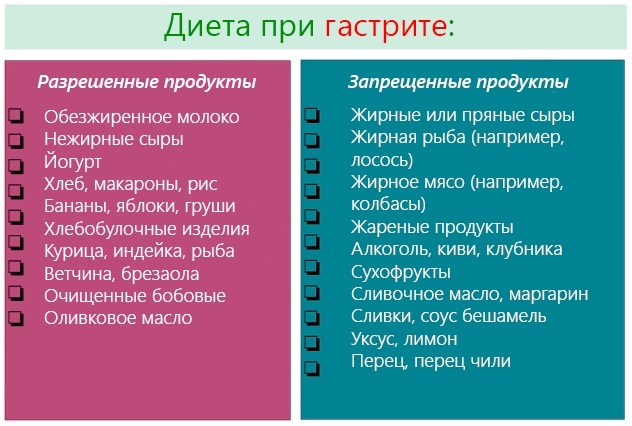
Key recommendations:
- You can't eat a lot of food in one sitting. Meals should be fractional, that is, eat in small portions of 200-300 ml in a volume of 5-6 times a day every 3-4 hours.
- Drink warm water 30-40 minutes before meals.
- The food you eat must be chewed thoroughly.
| Allowed food for gastritis | Prohibited foods for gastritis |
|
|
Clinical guidelines
To exclude acute gastritis, it is necessary to adhere to proper nutrition and its regimen.
The following recommendations of doctors should be observed:
- exclude harmful factors (alcohol, smoking);
- move more;
- timely diagnose and treat pancreatitis, cholecystitis and other diseases of the gastrointestinal tract;
- do not eat before bedtime;
- observe equal intervals between meals;
- avoid spicy, fried, and hot foods.
Gastritis is one of the most common diseases of the gastrointestinal tract. When the first symptoms appear, you should immediately seek medical attention. The sooner treatment is started, the lower the risk of possible complications for the health of women and men.
Video about gastritis
What is gastritis and its symptoms:


